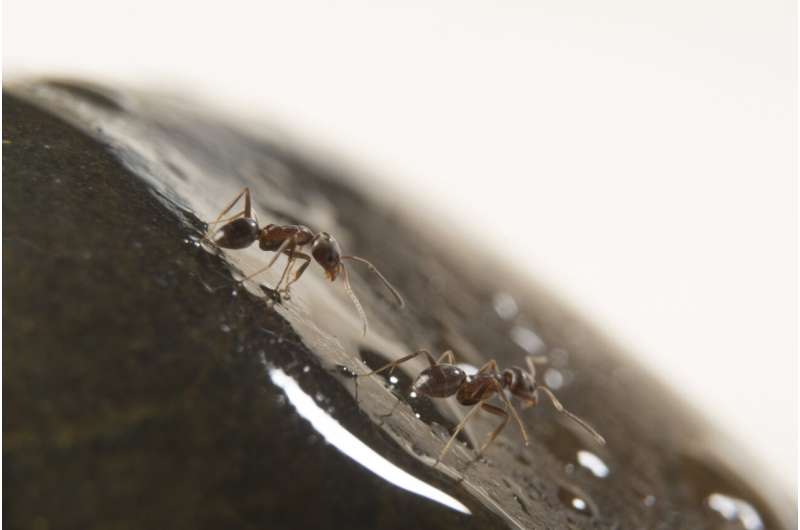This article has been reviewed according to Science X's editorial process and policies. Editors have highlighted the following attributes while ensuring the content's credibility:
fact-checked
peer-reviewed publication
trusted source
proofread
To groom or not to groom? 'Triage' in the ant kingdom

Social ants are masters of cooperative disease defense. They collectively take care of each other to prevent the spread of infections within a colony. But how does an individual ant know whom it should groom? A multidisciplinary team of researchers from the Institute of Science and Technology Austria (ISTA) and the Comenius University Bratislava combined experimental and theoretical approaches to get a detailed look into ants' sanitary decision-making.
Ants are a perfect model for the study of cooperation, especially when it comes to preventing the spread of disease. Similar to a hospital, healthy individuals take care of sick ones. However, while a hospital has established rules of triage to determine whom to treat first, the individual decisions that ultimately form the collective hygiene of an ant colony have been unclear. Until now.
To unravel an individual ant's decision-making when treating colony members, experimental biologist Sylvia Cremer and her research team at ISTA have teamed up with colleague and theoretical physicist Gašper Tkačik and mathematician Katarína Boďová from the Comenius University in Bratislava. In their multidisciplinary study published in the journal Nature Communications, the scientists used garden ants and fungal germs to understand what information ants take into account when performing their individual grooming choices.
Observation of the ants' behavior and analysis of the spore load—the amount of fungal spores—of each colony member over time revealed that ants preferentially target the most infectious nestmate for grooming. Additionally, ants do not groom other ants just after they were groomed themselves. Ants therefore not only assess the contagiousness level of others but are also sensitive to the social feedback they receive on their own infectiousness from the colony. This unique combination of simple rules leads to the fact that the most infectious colony members are groomed by the least infectious colony members, resulting in highly efficient colony-level disease control.
To elaborate on these rules, the scientists put ants in an experimental environment with two colony members, each carrying on their outside a different amount of fungal spores. The grooming ants could then decide how to administer their health care between the two colony nestmates. After careful behavioral observations, Barbara Casillas, previous Ph.D. student in the Cremer group, detected a fascinating phenomenon in the ants' grooming patterns.
Ants preferentially target the individuals that carry the highest amount of spores, which are the individuals that represent the greatest disease risk for the colony. "Ants typically pick the one with the currently highest spore load, although the spore loads are constantly changing due to the grooming itself," Cremer explains. "This allows the ants to dynamically react to changes in disease threat."
Theory to understand ant behavior
However, experimental approaches have their limits. The scientists could observe what ants are doing but could not decipher why they are doing it. Individual decision-making that forms group behavior remained a black box. Mathematician Katarína Boďová, assistant professor at Comenius University and Gašper Tkačik, theoretical physicist at ISTA, jointly took on the challenge.
Together, the team unraveled which information the ants make use of in their decisions about when to engage in grooming and whom to target. Boďová explains, "The ants follow a simple 'rule of thumb': When they encounter another ant with lots of spores, they are more likely to groom this ant." This means that the ants do not need to remember the spore load of all colony members but can rely on only the information they gather from contact with the ants around them.
Yet, the system is not perfect. The ants also sometimes groom the less-infectious individual. But the many small biases toward grooming ants with higher amount of infectious fungi performed by all colony members accumulate to a clear choice and efficient cleaning at the colony level. The ants can react to minimal differences in spore loads but make decisions that are more accurate when the discrepancy is higher.
"We still do not know how the ants sense the difference in spore load. Maybe the more infectious ants have a stronger fungal scent," Cremer hypothesizes. The group's recent publication suggests that ergosterol—an essential membrane compound that all fungi have—might be a possible cue for fungal detection.
Infectious ants do not participate in grooming
The theoretical approaches also revealed that another important factor is relevant to an ant's grooming activity: the ant's sensitivity to social cues given by their nestmates. Cremer explains it as a social feedback loop that prevents highly infectious individuals from taking care of others and thereby limits the risk of spreading the disease during caregiving.
More than just an interesting observation of ant behavior, this publication seeks to understand individual decision-making inside the colony. Cremer summarizes, "By teaming up with our colleagues doing theoretical science, we managed to open the black box of individual decision-making in social immunity and cooperative disease defense."
More information: Barbara Casillas-Pérez et al, Dynamic pathogen detection and social feedback shape collective hygiene in ants, Nature Communications (2023). DOI: 10.1038/s41467-023-38947-y
Journal information: Nature Communications
Provided by Institute of Science and Technology Austria


















